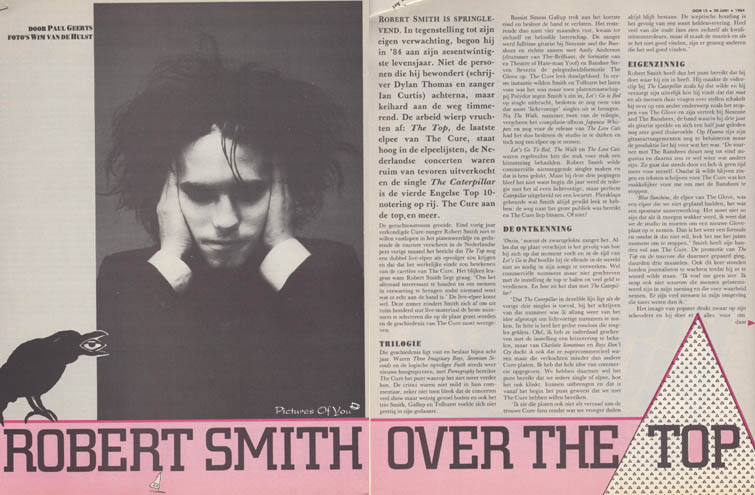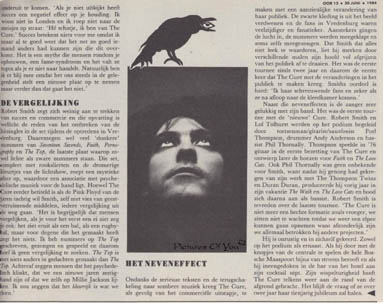"Robert Smith Over The Top"


June 1984 - OOR (Dutch)*
(Translation Below)
"Robert
Smith
Over
The
Top"


Over the top
Robert Smith is alive and kicking. In contrast to his own expectations, he started his twenty-sixth year of his life in 1984. He didnít follow the persons he admires (writer Dylan Thomas and singer Ian Curtis), but took his own route, working hard. His labour has been rewarded : The Top, the latest album of The Cure, has a high notation in the record-charts, the Dutch concerts were more than sold out and the single The Caterpillar is fourth in the English Top 10 notations in a row. The Cure at the top, and more.
The rumours kept growing. At the end of last year Cure-singer Robert Smith pronounced he didnít want to get caught in the web of the record companies and during the tour last month the news came out in the Dutch press that The Top would have a double live album as a successor and that would be the actual end of the career of The Cure.
They appeared to be lies, because Robert Smith loves telling a lie. ďTo keep things interesting and to get people confused, so no one knows whatís really going on.Ē
The live album, on the other hand, is coming. This summer Smith will be withdrawing himself from the world to select the best numbers out of over one hundred hours of live material to put on record to reflect the history of The Cure.
Trilogy
That history has been written and covers almost eight years. Were Three
Imaginary Boys, Seventeen Seconds and the like to follow Faith as new
highlights, with Pornography The Cure reached the point of no return.
The critics werenít mild with their comments, certainly not when the concerts
turned out to contain a lot of show, but they offered hardly any feelings and
also the trio of Smith, Gallup and Tolhurst didnít feel comfortable with this
transformation.
Bass player Simon Gallup had enough and decided to leave the band. The remaining duo took a four month lasting break, recovered and promised to do better. The singer became a fulltime guitarist for Siouxsie and the Banshees and founded the band The Glove together with Andy Anderson (drummer of The Brilliant, the band of ex Theatre of Hate-man Yoof) and Banshee Steven Severin.
The Cure seemed to be run down. At first Smith and Tolhurst wanted to leave things as they were, but when the record company Polydor brought out Letís go to bed against their will, they decided to bring out two more Ďlight-footedí singles.
After The Walk, number two of the trilogy, the compilation-album Japanese Whispers appeared and before the release of The Love Cats the duo decided to record another album.
Letís Go To Bed, The Walk and The Love Cats became hits straightaway. Robert Smith wanted to create commercial meaningless singles and he succeeded. But they didnít stop with these three attempts, because at the beginning of this year the trilogy was extended with the also light-footed, but perfect Caterpillar. And suddenly happened what Smith always wanted: they reached a big audience and The Cure started to earn money. Or not?
The
Denial
ďRubbishĒ, the black-haired singer explains. Everything on the album is the
result of how he felt at the time and during the period of Letís Go To Bed
he didnít want his songs to be about the miseries of the world. The songs were
commercial but werenít written to reach the top or earn large amounts of money.
And what about The Caterpillar?
ďThat The Caterpillar is in the same line as the last three singles is a coincidence, when I wrote that song I didnít want to make light-footed songs anymore. In fact the whole fuss round those singles is waffle. Okay, indeed I wrote them to get in the charts, but I suspected Charlotte Sometimes and Boys Donít Cry to be super-commercial but they sold less than other Cure-records. Iíve given up the whole idea of being commercial. Because of that we were able to bring out every single or album that we liked and that was what we wanted for The Cure from the beginning.
ďI donít see those records as treachery to loyal Cure-fans, because what we used to do will always exist. The sceptical attitude is the result of some kind of hero-adoration.
Many of those old fans see themselves as quality controllers, but I am making the music and if they donít like it, there will be enough others who will.
So Robert Smith has reached the point were he can do the things he likes best.
He made the music video for The Caterpillar the way he liked it and he takes care of his looks the way he likes it and if people are asking questions about it he switches to another subject like quitting The Glove and his withdrawal from Siouxsie and The Banshees, the band he played in for three years as a guitarist and where he felt quite at ease just six months ago. You can listen to his guitar arrangements on Hyaena but he left the production for what is was. ďThe tour with The Banshees goes on until the end of August and after that there probably will be something else. It goes on and on like that and I donít have any time for myself. Because I wanted to keep on singing and writing for The Cure it was easier for me to quit The Banshees.
ďBlue Sunshine, the album of The Glove, was an album we hadnít planned, it was a spontaneous collaboration. It shouldnít be like waking up tomorrow morning knowing that I would have to go into the studio to record a new Glove record. That would be like a formula and because I donít want that, it seemed to be the right moment for me to quit.Ē Smith has his hands full with The Cure. The promotion of The Top together with the tour took three months. Also this time there were hordes of journalists waiting for him to speak. ďI donít feel like a star. I donít get why those people are interested in my opinion and take that for truth. There are a lot of people who know more than IĒ.
The image of being a pop star weighs heavy on his shoulders and he tries hard not to let it get to him. ďIf you donít watch out success has a negative affect on you. I donít live in London and donít shout to girls on the street: Ďhey babe, Iím from The Cure.í Success means nothing to me, because I know that this could happen to anyone else just as well.
Itís a myth that people create around you, a fame syndrome and it disappoints them if you donít act on it. Of course Iím glad it enables us to make a new record, but it doesnít go beyond that.
The
comparison
Robert Smith says he doesnít take the success and commerce seriously and that
assumption is maybe the reason for the lack of the hit singles during the shows
in Vredenburg. Then again they played many Ďdarkerí songs from Seventeen
Seconds, Faith, Pornography and The Top, the latest record which has
lighter and heavier numbers on it.
That set, complete with smoke and dreamy colours from the lightshow, calls up a mystique atmosphere, through which an association with psychedelic music is self-evident. However The Cure has been titled as the Pink Floyd of the eighties Smith, himself not being averse to drugs, doesnít want to see any comparison. ďItís understandable that people make comparisons, if you see an egg for the first time, you would say: it looks like a ball, like a rugby ball, but for the one who made it, it means nothing. I wrote, sang and played numbers for The Top and thatís why I donít need to seek a comparison. The Top is made with nothing else on mind than The Top. Afterwards people will say it sounds psychedelic, that we are a new sixties band or even that we resemble Millie Jackson. I would say weíre colourful.
The
side effect
In spite of the serious lyrics and the change down to gloomy music The Cure, as
a result to the commercial trip, coped with a substantial change of its
audience. Black clothing has disappeared and the fans in Vredenburg were more
versatile and fanatic. Lighters went up in the air, there was clapping and even
singing along with songs.
Smith didnít seem to appreciate it, because several times he turned his head in horror away from the audience.
It was the first tour since two years and the first time The Cure was confronted with the changing audience. Smithís verdict is hard: ďI hate screaming fans, especially when they come to the dressing room afterwards.Ē
Beside the side effect the singer is very happy with his band. It was the first tour with the Ďnewí Cure. Robert Smith and Lol Tolhurst were accompanied on stage by keyboard player/guitarist/saxophonist Porl Thompson, drummer Andy Anderson and bass player Phil Thornally. Thompson played guitar in í76 with The Cure when they started and later on he designed the covers for Faith and The Love Cats. Phil Thornally offered his services as a bass player. Robert Smith is content with the last tour. ďThe Cure isnít as tight as it used to be, we canít just sit and wait until we record a new album, because we all are involved with other projects.Ē
He is restless and introverted. On stage as well as off stage. When he plays his guitar and screams his heart out and when heís crouched up in the bar of the hotel while sipping at his cocktail. The question remains if they will make it to their tenth anniversary in two years.
THANKS to: Marieke Klein Haarhuis for the TRANSLATION.